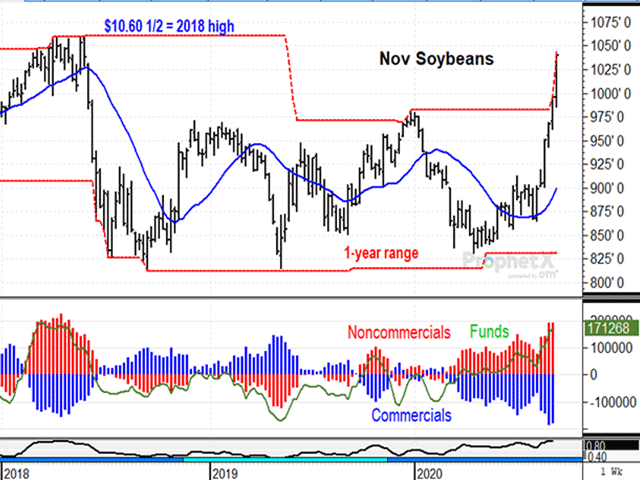Todd's Take
Anticipating Soybeans' Next High
It's hard to believe how quickly market attitudes can change, but they certainly have in soybeans the past six weeks. In early August, USDA said 74% of the soybean crop was rated good to excellent, the best-looking crop in at least 10 years and awarded it a record-high yield estimate of 53.3 bushel per acres (bpa).
Since then, hot and dry weather knocked the good-to-excellent rating down to 63% and USDA's yield estimate down to 51.9 bpa. But the thought of a smaller crop is only a small part of the current bullishness in soybeans. Once again, China is shocking the world with a level of demand that no one saw coming.
To date, the U.S. is holding 1.27 billion bushels (bb) of soybean export sale commitments for 2020-21, roughly 684 million bushels (mb) of which are from China and more are marked from unknown. The purchases picked up in mid-July as Brazil's supplies ran down earlier than usual. Friday's soybean export sale was the 11th consecutive announcement from USDA. Export commitments now represent 60% of USDA's soybean export estimate for a new season that still has over 11 months to go.
We look at China's high food prices and surmise the nation's cupboards are bare; but given the government's tight rein on information, it is difficult to know how serious the shortages are and where they come from. Possible contributing factors are African swine fever, coronavirus, summer flooding, crop damage from typhoons in northeastern China and possibly the consequence of minimizing U.S. purchases during the past two years of trade disputes with the U.S.
P[L1] D[0x0] M[300x250] OOP[F] ADUNIT[] T[]
Without a confident understanding of how bad things are in China, and not knowing how large actual needs are, it is even more difficult than usual to say just how far the current soybean rally may go. What's more, the planting season in Brazil is off to a dry start and end users have to be concerned about what might happen to world soybean supplies if South America's next crop runs into adverse weather.
Amid the fundamental confusion, I look at a weekly chart of November soybean prices and see two recent highs worth noting. The 2016 high of $11.86 1/4 capped a quick rally of over $3.00 in less than four months and was also fueled by an unexpected rush of demand. At the time, USDA estimated ending soybean stocks at 260 mb or 7% of annual use, a much tighter scenario than USDA's current estimate of 460 mb or 10% of annual use.
The 2018 high in November soybeans took place in late May, shortly before the trade dispute erupted between China and the U.S. The peak of $10.60 1/2 is not far from where soybeans are currently trading and happened at a time USDA estimated 415 mb of U.S. ending soybean stocks or 9% of annual use -- closer to today's situation.
The other similarity between 2018 and the present is that noncommercials were heavily net long near the peak -- a common finding in bull markets. In 2018, 80% of speculators were long and noncommercial net longs hit a peak of 224,357 in mid-April, a couple months before prices topped out.
As of Sept. 8, CFTC data shows 80% of noncommercials on the long side of the market, holding 192,429 net longs. As prices have rallied sharply since Sept. 8, noncommercial net longs are expected to be even larger in Friday afternoon's update.
I can't emphasize enough the amount of uncertainty in the present situation concerning soybean prices. Even so, it is not a stretch to say soybean prices have gotten to levels that deserve serious selling consideration from U.S. producers. The traditional seasonal pattern was turned upside down by COVID-19 in 2020 and it is quite possible this year's prices will peak at a time when we normally witness harvest lows.
With heavy speculative participation and a highly uncertain demand environment, it is still possible U.S. soybean supplies are headed to a tight situation and higher prices. So far, the producers that have benefited the most have done so by putting off their marketing decisions, but that doesn't work most years and may not eventually work this time either.
I can't guarantee a top is close, but conditions are ripe. Producers who haven't yet sold the crop they're about to harvest should get started making some sales now.
Todd Hultman can be reached at Todd.Hultman@dtn.com
Follow him on Twitter @ToddHultman
(c) Copyright 2020 DTN, LLC. All rights reserved.




